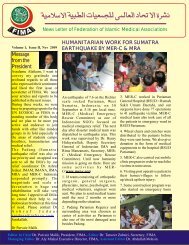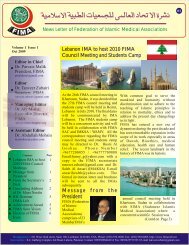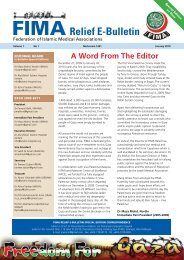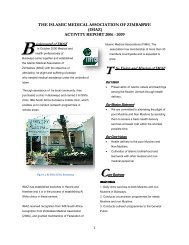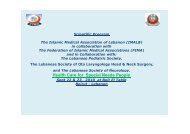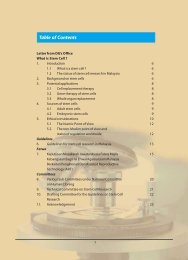FIMA Year Book 2009 - Federation of Islamic Medical Associations
FIMA Year Book 2009 - Federation of Islamic Medical Associations
FIMA Year Book 2009 - Federation of Islamic Medical Associations
You also want an ePaper? Increase the reach of your titles
YUMPU automatically turns print PDFs into web optimized ePapers that Google loves.
Problem Based LearningIntroduction:Learner centered education is currentlyan accepted international standard <strong>of</strong>excellence in the world <strong>of</strong> graduate aswell as undergraduate education. Theconcept <strong>of</strong> learner centered education isnot a new one. The shift from traditionalTeacher Centered Learning to currentStudent Centered Learning in medicineoccurred in 1970’s. Student CenteredLearning is also termed self directed orlearner centered learning. Self directedlearning, SDL, is defined as studentstaking the initiative and subsequentsteps for their own learning: studentslead in diagnosing their learning needs,formulating multidimensional goals anddesired learning outcomes, identifyingacademic and contextual resources,working in groups in prioritizing andimplementing appropriate tasks andactions and finally evaluating their ownoutcomes (1) .Learner Centered Education is,therefore, the most widely acceptedapproach to fulfilling the needs <strong>of</strong> AdultLearning in any educational systemincluding medical education (2) .Adults are motivated by learning that:• Is perceived as relevant• Is based on, and builds on, theirprevious experiences• Is participatory and activelyinvolves them• Is focused on problems• Is designed so that they cantake responsibility for their ownlearning• Can be immediately applied in practice• Involves cycles <strong>of</strong> action andreflection• Is based on mutual trust andrespect, (3)It can be clearly seen from abovedescriptions that concepts <strong>of</strong> SDL andAdult Learning are quite concordant.Self directed learning is an activeprocess. It encourages the adoption<strong>of</strong> the deep approach to learningfirst. Deep learning, as opposed tosurface learning, is an active search forunderstanding. Surface learning merelyencourages students to reproduce whathas been learnt. Research has identifiedthe student’s approach to learningsurfaceor deep-as the crucial factorin determining the quality <strong>of</strong> learningoutcomes, (5) . A surface approach iscommon in courses that have a heavyworkload, an unrealistic and excessiveamount <strong>of</strong> course material, little orno opportunity to pursue subjects indepth, dictated choice over study areasand topics, and an examination orassessment system that provokes anxietyand mainly rewards rote memory andreproduction <strong>of</strong> facts even in absence <strong>of</strong>ability to apply that knowledge in reallife situations.Education systems that aim for deeperlearning, on the other hand, providea context in which main motivationis the learner’s need to know, (5) . Suchsystems support active learning andexploratory study through researchin small groups supported by a wellstructured knowledge base and preconceivedlearning outcomes. Aimsand objectives, modes <strong>of</strong> information<strong>FIMA</strong> <strong>Year</strong><strong>Book</strong> <strong>2009</strong>48







